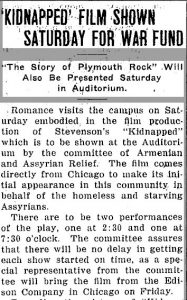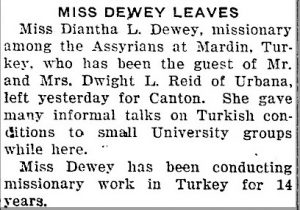Since at least 1941, Assyrian students have been attending the University of Illinois. Early Assyrian Illini have included athletes, coaches, engineers, entrepreneurs, ethnomusicologists, mathematicians, mechanical engineers, professional football players, and wrestlers, to name a few.
Read on to learn more about early Assyrian Illini!
Ancient Near East Historians and Assyrian Cultures on Campus
The Campus Near East History Program
Before the first Assyrian students came to campus, some Illini were already discovering the history and legacy of Assyrian peoples. During the early twentieth century, the University faculty included Ancient Near East scholars like distinguished Assyrianologist Dr. Albert Ten Eyck Olmstead. Of course, in time, the Library developed a Syriac Language collection too.
From 1917 through 1929, Professor Olmstead Ancient History was also a curator of the University Oriental Museum (now Spurlock Museum) [1]. Previously a Professor at University of Missouri, Dr. Olmstead was recruited by the University in 1917. For over a decade, Professor Olmstead taught courses in Near East Ancient History and he was a regular campus speaker too. In addition to his research, later in life Dr. Olmstead was remembered for personally visiting and walking nearly every historic site which he researched–no matter how remote–because of a personal belief in the value of personal experience in research. [2] Some of Dr. Olmstead’s campus talks included ancient gardens and legacies of Ancient Assyrian civilization.
Near East Relief Work
By the time Dr. Olmstead arrived on campus, many Assyrians peoples had suffered greatly under World War One fighting resulting in a humanitarian crisis felt on campus. At this time, some Assyrians came to Urbana-Champaign to talk about the humanitarian relief needs and current work. During a tour of Illinois cities, including an invited talk in Urbana at a meeting of the Urbana Association of Commerce, Prince Isaac M. Yonan came to town to speak about the history of Assyrians in the Near East. [3] The Prince’s arrival came during the negotiations of the Lausanne Conference which negotiated the final partitioning of the Ottoman Empire following World War One. In great detail, Prince Yonan’s talk described “[t]he story of a thousand years of suffering”, The Daily Illini summarized.
Local community members and University members organized a Near East Relief Committee to coordinate donations to Armenians, Assyrians, and other affected peoples. In 1917, one fundraising event featured two screenings of the new silent film Kidnapped, based on a story by Robert Louis Stevenson. Donations continued to be collected through the 1920s. By that time, History Professor Albert H. Lybyer had become head of local efforts following his service in the Inter-Allied on Mandates in Turkey American Section, which involved traveling Anatolia and other part of the former Ottoman Empire.
During the the years of Near East Relief work, some missionaries from the region visited local religious institutions and spoke about their experiences. At this time, it was a regular practice for some Illini to participate in missionary work after graduation. [4]
Local Interest in Assyrian Cultures
While local community members donated to the Near East Relief, some students expressed an interest in Assyrian cultures. In 1920, at a dance performance including multiple student performers, Etta Larry performed an “Assyrian flower dance“. In 1922, S. L. Pearlman performed an “Assyrian sword dance“. Unfortunately, no further documentation for either performance has been located yet. However, in 1924, one student wrote a poem about the Illini sports team which was a tribute to English poet Lord Byron’s poem “The Destruction of Sennacherib” about a failed Assyrian siege of Jerusalem. (Designed to be read aloud, the following poem’s rhythm should sound like the gallop of horses.)
Early Assyrian Illini
The Agases
Alexander A. Agase
The first Assyrian student may have been Mr. Alexander “Al” “The Assyrian” Arrasi Agase, (B.S. Physical Education, 1947) . [5] Mr. Agase was an All-American guard and a linebacker on the University football team in 1942 and 1946. He was also a heavyweight wrestler too. The Daily Illini has hundreds of articles (and at least one cartoon) about Mr. Agase’s athletic accomplishments. Mr. Agase’s studies were interrupted by his service during World War Two. After returning to campus, Mr. Agase resumed his successful career in football. After graduation, Mr. Agase played professional football in Los Angeles and Chicago, before joining the coaching staff at Northwestern University. Towards the end of his career, Mr. Agase became the Athletic Director at East Michigan University until his retirement.
While multiple memorials to Mr. Agase feature his decorated service in World War Two and his outstanding career as both a football player and coach, Mr. Agase’s student records add even more to his story. On many occasions, student publications refer to Mr. Agase with the nickname “The Assyrian” which was used in conjunction with his impressive physical size and performance. The first Daily Illini mention of Mr. Agase as “the Assyrian” may be in 1941, in an article by Frederick William “Fritz” Jauch, (B.S. Journalism, 1943). Other Illini writers continued using the name, like Mr. Dick Walker who wrote about one enthusiastic locker room chant which escalated from recommending Mr. Agase for local mayor to Governor of Illinois. Mr. Jauch continued to use nickname “the Assyrian” until 1943, when he graduated and when Mr. Agase left for military service. Upon Mr. Agase’s return to campus after the war, the nickname may not have been commonly with a few exceptions.
Louis Agase
Mr. Louis “Lou” Agase, (B.S. Physical Education, 1948) was both the brother of Alex and a distinguished athlete himself. Mr. Agase was a heavyweight wrestler, a noted football player, and a track star too. In 1945, Daily Illini writer Glenn Roberts lauded Mr. Agase’s freshmen wrestling performance for having “outstanding spirit“. In fact, while his older brother Alex was away in the war, Louis entered wrestling without his brother’s knowledge, Daily Illini writer Gene Shalit reported in an interview with Louis. In another article by Mr. Shalit, it was reported that Mr. Agase was quite modest about his athletic accomplishments. Of course, the Daily Illini was sure to report when Mr. Agase “really tackled a big one” when he proposed to Ms. Eileen Huebner (B.A., LAS, 1948).
After graduation, Mr. Agase enjoyed a long career of coaching. First, he was the head football and track coach at the high school in Paxton, Illinois, where he introduced the wrestling program too. A few years later, Mr. Agase returned to the University as a Junior Varsity football coach. During the late 1950s, he joined the coaching staff at Michigan State University. Then, during the early 1960s, Mr. Agase became Head Coach of the Toronto Argonauts.
The Miners
Edward N. Miner
Mr. Edward Nimrod Miner, (B.S. Mechanical Engineering), of Cicero, Illinois, was the son of Assyrian immigrants from Ada, Iran. [6] Although he enlisted and he served in the Navy during World War Two, the war had ended before he arrived in the Pacific Ocean. Supported by the GI Bill, he came to he University to study. After graduation, Mr. Miner worked in multiple manufacturing companies in the Chicago area, until relocating to California where he worked until retirement.
Robert N. Miner
Mr. Robert Nimrod Miner, (B.S. L.A.S, Teaching of Mathematics, 1963), of Cicero, Illinois, had an exceptional career as one of the founders of Software Development Labs (now Oracle Corporation).
Student Organizations
Today, since 2015, the Assyrian Student Association at UIUC organizes cultural events and educational workshops, while supporting humanitarian aid to Assyrian immigrants. Some campus events have included dance workshops, language instruction, and social events open to Assyrians and Illini everywhere.
Are you an Assyrian Illini? Do you know someone who is? We’d like to hear from you! Please send us a message or leave a comment below. We want to include you and your story, as we celebrate the first 150 years of the University of Illinois.
Happy First 150 everyone!
References
[0] Some errors in the above may be possible. The author attempted to be distinguish between sources labeled “Assyria” which refer to the state of modern Syria from “Assyria” which refer to Assyrian peoples who have lived in the regions encompassing modern Turkey, Iraq, and Iran today. This blog post may be expanded with additional information at a later date.
[1] For a brief biography, please see: Wilson, John A. “Albert Ten Eyck Olmstead, 1880-1945.” Bulletin of the American Schools of Oriental Research, no. 99, 1945, pp. 3–4.
[2] For a detailed biography, please see: Wilson, John A. “Albert Ten Eyck Olmstead, 1880-1945.” Journal of Near Eastern Studies 5, no. 1 (1946): 1-6.
[3] William Oldfather was born in Tehran, and his father taught Prince Yonan.
[4] During one missionary summer camp, one Assyrian student reportedly told others that his life’s ambitions in missionary work and his faith were to avenge the deaths of his parents. Please see: “Plans Made for Next Year at Lake Geneva“, The Summer Illini, June 19, 1920, pages 1 and 6.
[5] “Alex Agase Dead at the Age of 85“, fightingillini.com, May 4, 2007.
[6] “Edward N. Miner, 1927-2013“, Napa Valley Register, January 22, 2014.
[7] One alumni mentioned having an Assyrian neighbor, as an undergraduate during the 1960s; but no further information is available. Please see: “C’Mon Auler“, Daily Illini, March 13, 1966.




















